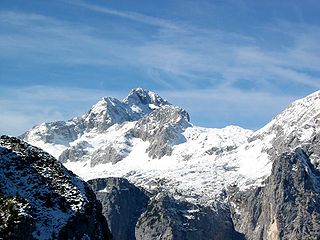
Slovenia offers tourists a wide variety of landscapes: Alpine in the northwest, Mediterranean in the southwest, Pannonian in the northeast, and Dinaric in the southeast. They roughly correspond to the traditional regions of Slovenia, based on the former four Habsburg crown lands. Each offers its own natural, geographic, architectural, and cultural features. Slovenia has mountains, meadows, lakes, caves, and the sea, making it an attractive destination in Europe.

The Sava is a river in Central and Southeast Europe, a right-bank and the longest tributary of the Danube. It flows through Slovenia, Croatia and along its border with Bosnia and Herzegovina, and finally through Serbia, feeding into the Danube in its capital, Belgrade. The Sava forms the main northern limit of the Balkan Peninsula, and the southern edge of the Pannonian Plain.

The Triglav Lakes Valley is a rocky hanging valley in the Julian Alps in Slovenia, below the sheer sides of Mount Tičarica and Mount Zelnarica southwest of Triglav. The valley is also called the Seven Lakes Valley, although there are ten and not seven lakes in the valley. It is above the tree line and is geologically alpine karst; therefore it has also been termed the Sea of Stone Valley.
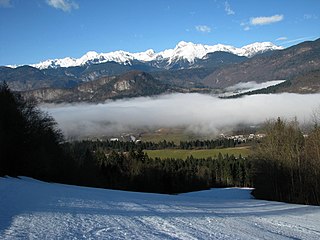
Bohinj, or the Bohinj Valley or Bohinj Basin, is a 20 km long and 5 km wide basin in the Julian Alps, in the Upper Carniola region of northwestern Slovenia. It is traversed by the Sava Bohinjka river. Its main feature is the periglacial Lake Bohinj. Bohinj is part of the Municipality of Bohinj, the seat of which is Bohinjska Bistrica.

The Sava Dolinka is a headwater of the Sava River in northwestern Slovenia. The 45 kilometres (28 mi) long Sava Dolinka starts as Nadiža Creek in the Planica Valley under Mount Zadnja Ponca in the Julian Alps, at an elevation of 1222 m, close to the Italian border. The stream goes underground soon after its source and breaks out again after 5 km at an elevation of 842 m in Zelenci, near Kranjska Gora. The Sava Dolinka flows through Kranjska Gora, Gozd Martuljek, Jesenice, between Bled and Breg, and past the town of Lesce. The first in a series of hydroelectric power plants on the river, the Moste Hydro Power Plant, is located near Žirovnica. It merges with the second major headwater of the Sava, the Sava Bohinjka, at Radovljica. Tributaries of the Sava Dolinka include the Triglav Bistrica at Mojstrana and the Radovna, which flows through the Vintgar Gorge near Bled.

The Municipality of Gorje is a municipality in Slovenia. It was established in 2006 and came into existence on 1 January 2007, when it split from the Municipality of Bled.
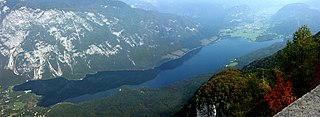
Lake Bohinj, covering 318 hectares, is the largest permanent lake in Slovenia. It is located within the Bohinj Valley of the Julian Alps, in the northwestern Upper Carniola region, and part of Triglav National Park.

Bohinjska Bistrica is the largest settlement and administrative centre of the Municipality of Bohinj, in the Upper Carniola region of northwestern Slovenia.
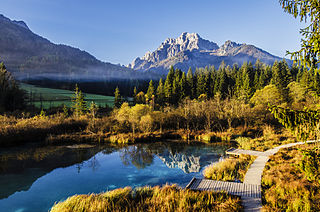
Zelenci Springs is a nature reserve near the town of Kranjska Gora, in the far northwestern corner of Slovenia. It is the source of the Sava Dolinka River, a tributary of the Danube.

Mojstrana is a village in the Municipality of Kranjska Gora in the Upper Carniola region of Slovenia.

Krma is an alpine valley in the Julian Alps in the Upper Carniola region of northwestern Slovenia. The entire valley lies in Triglav National Park.

Vintgar Gorge or Bled Gorge is a 1.6-kilometer (0.99 mi) gorge in northwestern Slovenia in the municipalities of Gorje and Bled, four kilometers northwest of Bled. It is located on the edge of Triglav National Park. Carved by the Radovna River, it is the continuation of the Radovna Valley. The sheer canyon walls are 50 to 100 meters high, with a total slope measuring about 250 m (820 ft). The stream has created many erosive features such as pools and rapids, and terminates in the picturesque 13 m (43 ft) Šum Falls, the largest river waterfall in Slovenia.
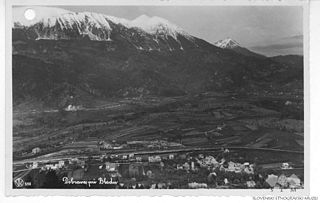
Blejska Dobrava is a settlement in the Municipality of Jesenice, in the Upper Carniola region of Slovenia.
Zgornja Radovna is a dispersed settlement in the Municipality of Kranjska Gora, northwestern Slovenia, belonging to the traditional region of Upper Carniola. The village lies at the juncture of the Kot Valley and the northern part of the Krma Valley. The Radovna River, a tributary of the Sava Dolinka, emerges under the Jutrova Skala Slope in the northeastern part of the settlement.
Radovna is a settlement in the Radovna Valley in the Municipality of Gorje in the Upper Carniola region of Slovenia.

The Municipality of Kranjska Gora is a municipality on the Sava Dolinka River in the Upper Carniola region of northwest Slovenia, close to the Austrian and Italian borders. The seat of the municipality is the town of Kranjska Gora. It borders Italy & Austria.
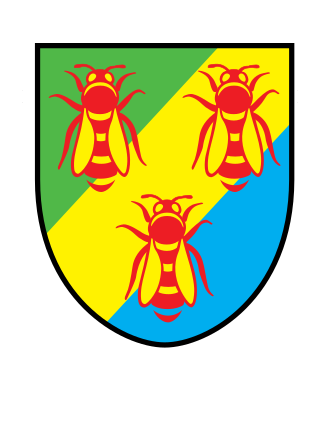
The Municipality of Mirna Peč is a municipality in southeast Slovenia, located in the traditional region of Lower Carniola. The seat of the municipality, which was established in 1998, is Mirna Peč. With an estimated population of 2,800, the municipality is included in the Southeast Slovenia Statistical Region.

















